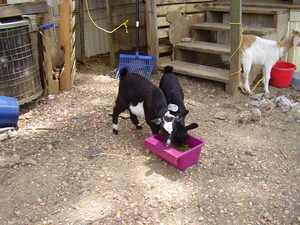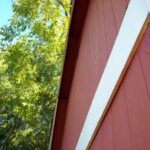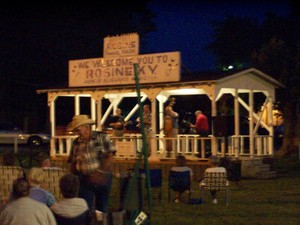Many people think to have a farm and provide food for their home they must have a 30 or 40 acre place. With three good agriculture zoned acres you can do more than you think! With planning and opportunity you can do an incredible amount on three acres!
A large barn is key – with this you can have a dry place to work on machinery when it breaks, you can store tools and equipment. A run in shelter allows room for calves, sheep or other livestock. Some raised hanging cages offers a safe enclosed place for raising rabbits. Running water and electric makes things much easier. A 30X40 barn gives room for lambing or kidding stalls, horse and/or calf stalls, loft overhead allows for straw and hay storage, rabbits and small stock have plenty of room, place to store feed that’s dry and bug free. If you have this indoor room, especially with a run in three sided shelter and a paddock you can keep a dozen or so sheep, a cow, horse or goats. A 1/2 to 3/4 acre paddock properly maintained and fertilized can give grazing for the animals, although you can expect to have to buy hay to avoid overgrazing your pasture. Ideally have two or even three pasture areas – you can rest one while using another. Making maximum use of your pasture is a smart plan – grass is converted to meat. As animals graze they’ll fertilize. If you don’t have poultry it will help to go out twice a month or so and spread manure piles out then rotate to another field. This helps control parasites, breaks up the piles to help rather than hurt the pasture. If you have a riding mower (advised for periodic mowing) it can be as easy as an old piece of chain link fence attached to the back of it, and drag the pasture once or twice a month. This isn’t as big of a deal for sheep as cattle or horses; but is a part of proper maintenance.
A three sided shed and 16X32 pen allows raising four pigs at a time easily. A 10X16 attached or freestanding poultry area allows plenty of room for chickens. Once trained the chickens, a few ducks or geese, turkey or guineas can make use of the pasture area and/or garden or other areas. They’ll search for bugs, keep fly populations and other bugs in check and it reduces the amount of feed you’ll have to buy. Feeding them at night gets them back into their confined, protected area to keep them safe from predators. You might have a room or area on one end to serve as a brooder – one that can be temperature controlled but still have decent ventilation.
Around the home instead of conventional landscaping make use of herbs in the raised beds. Tightly confine plants such as mint and others that spread quickly and easily. A 2X3 area of mint can net as much or more than most people will use! Look at basil, peppers and other plants to provide ornamental as well as food benefits. There is plenty of room for a conventional garden, flower beds, a few fruit trees, even a few nut trees. Planning is the key. A sugar maple on each side of the driveway entrance can be decorative and in later years you can tap the trees for sap for maple syrup. Looking for something for in front of the deck? How about blueberry bushes?
The caution – keep Black Walnut, cherry and maple trees away from pastures. Research your plants – if you’re wanting a couple trees in front why not use English Walnut or pecan? You’ll have shade trees *and* eventually nuts, which continue to climb at the grocery store and can easily be grown at home! Two or three pecan trees in a good year will give you all the pecan pies you’re likely to want! Make use of the border fence near the garden – blackberry, raspberry, cherry bushes and other smaller bush type plants can produce food and make use of that space.
There’s nothing to say you can’t have flowers – did you know nasturtiums, pansies and many other flowers are edible? You can enjoy the flowers and perk up the salads! Lavender and other plants can be enjoyed – and harvested for potpourri.
Three or four acres isn’t a lot of land – but if efficiently managed can provide an enormous amount of food! You may not have a ten acre woodlot – but the extra pig you raised around back can be bartered for firewood! Or if you’re an opportunist, look for downed trees after storms and get free firewood! If you have room for 10 acres of crops great – but if not plan carefully, make contacts and make the most of your feed dollar. Near the garden area have several compost bins – you can use leaves, grass from the lawn, kitchen “waste”, manure from under the rabbit cages and the stalls/pens.
A good investment – on a 3-4 acre spot you may not have enough use for a big tractor, but a good riding mower/garden tractor and pull behind cart and attachments is invaluable! Store the cart near the stalls, toss dirty bedding and manure into it and every few days haul it past the pig pen to clean it and toss in droppings from the rabbits – once you get a routine this will take just a few minutes. Put it on the compost pile. For those with 1,000 head of animals – and some with even 100 that lack a plan – manure is an annoying waste – for you, composting it, it’s a valuable commodity for your garden! Learn to maintain a compost pile and you’ll be amazed at the boost in fertility – and it’s less bagged or other fertilizer you need to buy. If you have a good deep pile, some will even compost the occasional chicken that dies or other small animal. While not ideal, at the bottom of a 3′ pile it will heat up and add to the fertility. With a garden tracter you can mow pastures if needed, make short work of a yard area, till the garden and many other chores. Take care of your equipment – it’s an expensive investment but one that, with proper servicing and care, will last you 10-15 years or more. Get GOOD quality parts. A tip – if you have a garden tractor find out for sure what belts it needs, and always keep two of each on hand as well as a set of blades. Sometimes stores can take a while to get them in and if you’re needing a belt to complete a project it’s not good. And if the belt is a $40-50 item, having it there on hand means you can continue on and have a few weeks to get the replacement in your stock. Also keep on hand fuel/oil/air filters for it.
While it’s not as exciting have an area of the barn or garage that’s a shop area. A workbench and proper tools makes repairs of many things much easier! Learn to sharpen blades for the mower, change the oil in your car and other things that should be done on a regular basis. Tip – when you change the oil in your car take a medium sized plastic tub (like can be found at Dollar General for about $4-5) and put sand in it about a foot deep or better. Take the old oil and pour it into this sand – periodically stir and “treat” your shovels, rakes and other things to keep them rust free. The lid keeps pets and animals out of it – use a black marker to clearly mark on it what it is. In the barn or shop have a garden area – your work bench may do double duty here. A potting bench, starter tray set up and good compost and starter can provide an early start to grow your own seedlings for tomatoes, peppers and other crops many just buy. Once you get the equipment you can use timers on lights and keep it watered – very easy and it can save you a lot of money.
A small pen can be a means to raise pigeons for squab, as a hobby or to enjoy. Many have started keeping pigeons just to enjoy them then raise white pigeons and train them to be released at weddings, funerals and other functions. Typically homing pigeons, these birds carry a band and when released will simply fly home to food and water!
Have a good pantry and/or root cellar. Remember when you’re growing things at home you’ll be doing the “processing” – canning, drying, packaging and such falls to you. Again – get good equipment. Good equipment can easily last 10-15-20 years – that makes a few hundred dollars almost not significant when spread out and used. Good canning jars might cost you $100 – or if you’re lucky to find someone giving them away you’ll just need to buy the bands and lids! But these can last for years, barring accidental breakage. The jars salsa and other things come in store bought are *not* recommended for canning – but you *can* clean them out and use them to store dried basil, dried mint and many other things! Be sure to mark and label everything. You might think you remember but you’ll want to rotate and be sure to use the oldest first – if it’s marked and labelled there’s no question. One of the purchases – a good freezer. Remember you’ll be stocking up. When you have two hogs butchered that’s about 360 pounds of meat! Add in the garden harvest. Add in the 25 meat chickens, the turkey and the half side of beef you traded one of the other pigs for! You’re quickly up to having easily a half ton of food on hand. Remember this is your food supply! Consider carefully if a propane freezer might be worth the expense or a generator – if power is out for a few days you don’t want to lose 500 pounds of meat! A $300 generator is worth it even if it just runs your freezer in an outage. You can cook on a camp fire – but keeping your food safely stored is vitally important. Don’t count on the power company. Some people even run a small solar or wind and battery system just for their freezer. But really think about keeping your food supplies guarded and properly stored.
If you have a pasture seeded with some clover, fruit trees and others you may consider keeping bees either in a hive or encouraging wild bees (not the Africanized ones) – bees are good as they help with pollination and help provide an abundant crop. Attracting butterflies and other “wildlife” also helps towards this. Many people enjoy feeding the songbirds in the area. Living with wildlife can be beneficial – while you don’t want to attract raccoons, hawks or owls to the poultry house there are some animals that can live without harassment. While skunks and snakes are not people’s favorite creatures, non toxic snakes can keep rodent populations down, meaning less feed loss to mice or rats. Putting up bat houses and attracting bats is something many are squeamish about – but most of the time you won’t know they’re there – and yet at night they’ll dine on mosquitos and other bugs. A few Bluebird houses at the corners of the property can be a place for those birds to nest. Purple martins and barn swallows are also often encouraged for their love of bugs. These are animals that can easily have a habitat on your property that you “feed” without costing you anything in most cases. Even $50 for bat or bird houses is cheaper than hundreds of dollars trying to control mosquitos! If you have free range chickens it’s best NOT to attract owls. For many types of wildlife it’s a case of provide shelter, food and water and they’ll come.
With 3-4 acres, planning and good management it’s realistic to be able to provide much of your family’s food bill at home. Each time food safety issues are regulated it removes the chance to buy direct – raising it yourself you KNOW what went into the meal you’re serving. The initial costs can be often bargained or bartered – but getting good quality equipment that lasts can’t be stressed enough. The minute you load that old freezer with 1500 pounds of food it’ll go out – be sure you have back up funds to be able to go get another immediately if that happens. Planning ahead becomes your responsibility. The rewards – a fresh, safe food supply. The ability to have last minute company and it’s not a problem – just pull something out of the freezer! For many it’s having a bigger variety of foods, seasonings and such than they would have “at the store.” While it’s not cheap to spend $200 on a freezer, $100 on canning supplies and so forth it’s also not cheap to have eggs at $2 per dozen, milk at $5 per gallon, meats climbing for no reason other than they can do it because there’s no competition (and questionable quality sometimes at that) and seemingly endless recalls and warnings about food safety. They use this to justify things like NAIS which will severely restrict the number of people being able to raise their own food even.
Three acres can provide much more than a bank account ever could. The $10,000 that isn’t accessible in the bank is worthless when you’ve been four days without food due to power outages. Security takes on a different meaning when you know you will have enough to eat for the next six to eight months. People get sick or injured, laid off – having a secure pantry can ease an incredible amount of stress!





